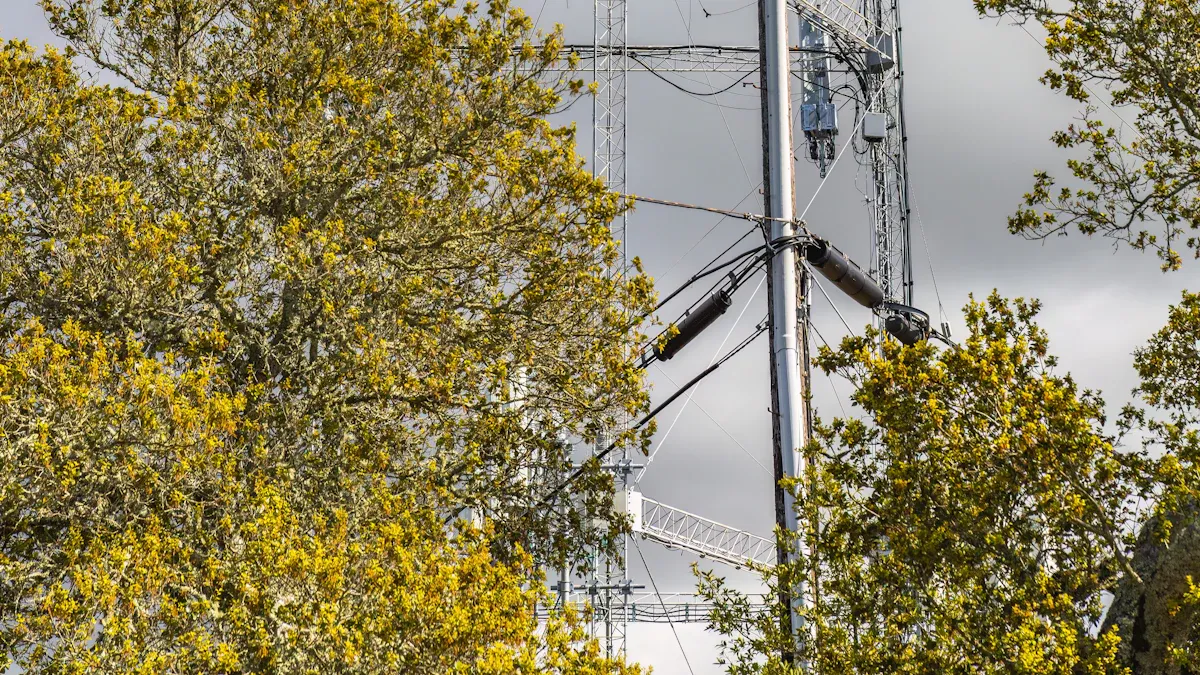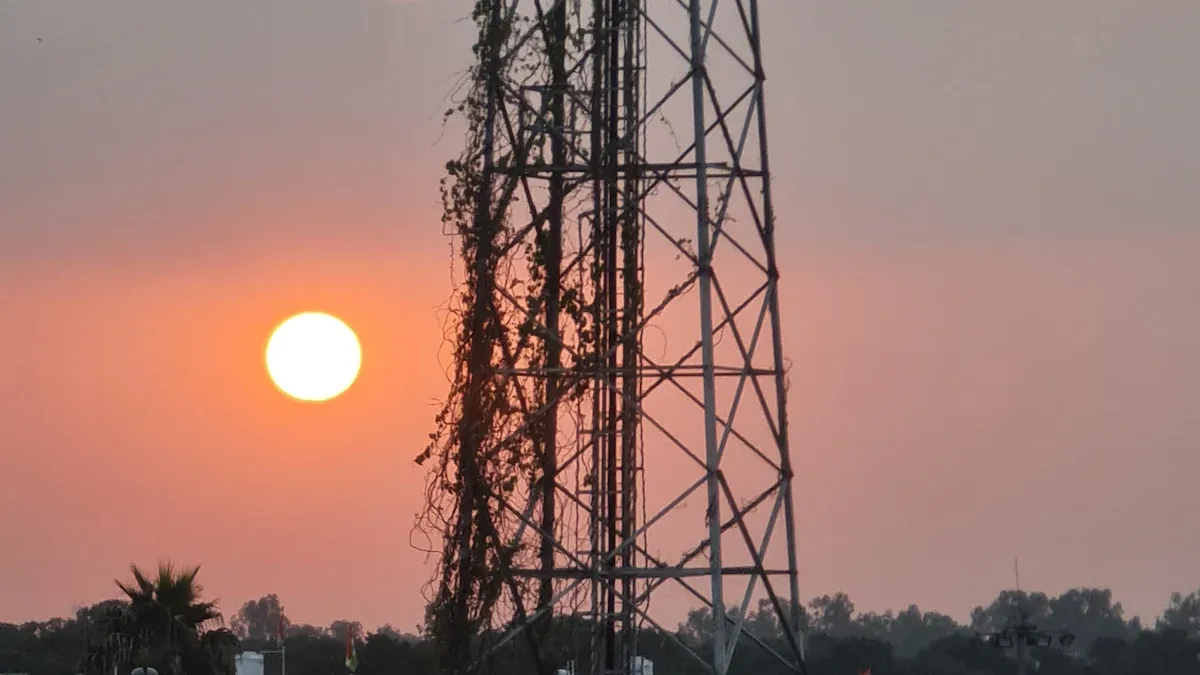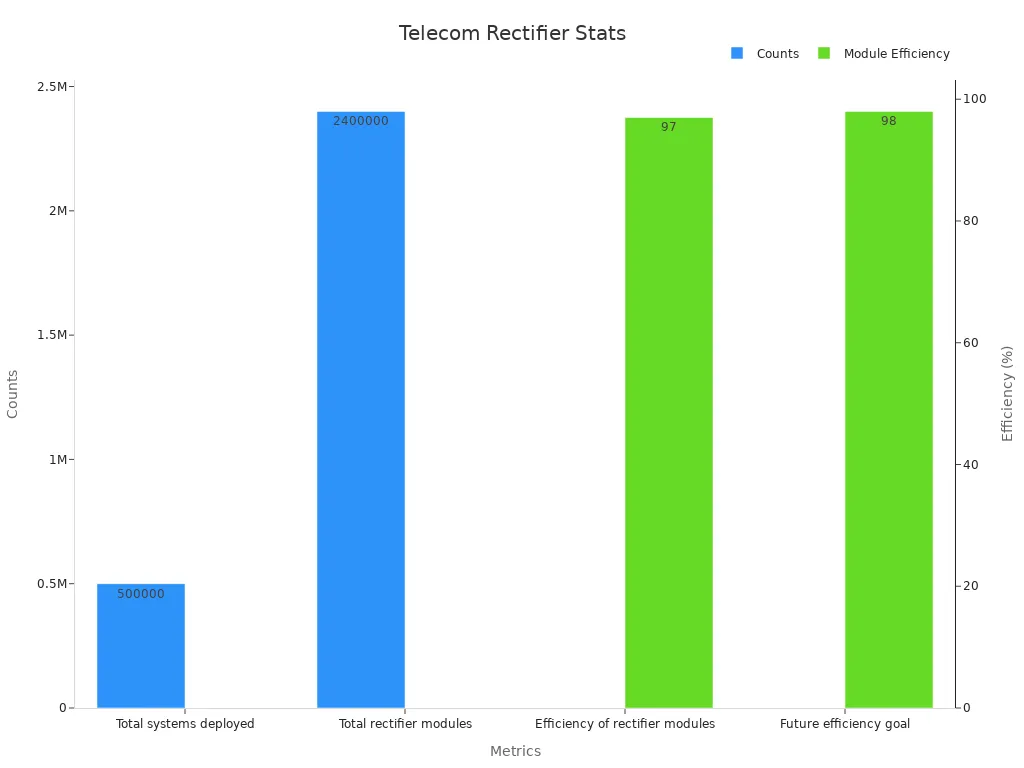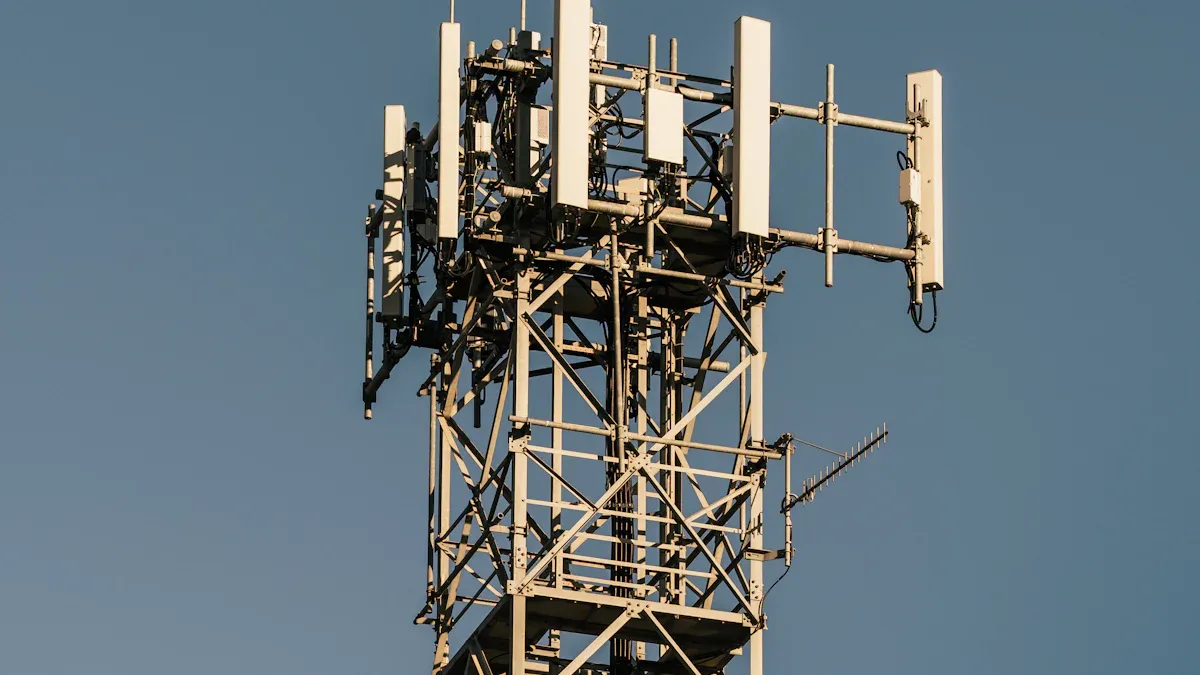What Does a Telecom Rectifier Do

A telecom rectifier changes alternating current (AC) into direct current (DC). This keeps a steady DC power supply for telecom systems. It helps communication networks work well, even if power changes. Its job is important for steady voltage and saving energy.
The growing telecom market shows rectifiers help stop AC overvoltage.
DC systems are popular because they waste less energy and work with renewable energy. They will hold 62.3% of the market in 2024.
Rectifiers give steady power to telecom towers, especially where grid power is not reliable.
Key Takeaways
Telecom rectifiers change AC power into DC power for steady energy.
Efficient rectifiers use less energy and lower costs, reaching 97% efficiency.
Rectifiers keep systems reliable by giving stable power and stopping voltage changes.
Backup power helps rectifiers work during outages, keeping networks dependable.
Picking a rectifier means checking power, strength, and efficiency for best results.
Core Functions of Telecom Rectifiers

Telecom rectifiers do important jobs to keep systems running. They change AC to DC, control voltage, and save energy.
Changing AC to DC
The main job of a telecom rectifier is to turn AC into DC. Telecom systems need steady DC power to work properly. AC from the grid changes direction and voltage, which can harm telecom equipment. Rectifiers fix this by turning AC into DC, which flows one way and gives stable power.
Rectifiers use different ways to make this change. Full-wave bridge rectifiers use the whole AC wave. This method makes better voltage conversion and higher DC output. But some energy turns into heat because of diode voltage drops. Over time, this heat loss can raise costs. Modern rectifiers reduce these losses for better performance and lower expenses.
Voltage Regulation
Rectifiers also keep voltage steady for telecom equipment. Telecom devices need a certain voltage range to work safely. Rectifiers stabilize voltage even when input power changes. This keeps networks reliable in different conditions.
New rectifier technology has improved voltage control. Top brands like Unipower and Huawei make systems with 96% efficiency, losing only 4% power. Class 4 systems handle voltages from 50V DC to 450V DC. They have safety features and fault checks to protect networks. These systems watch for problems and keep operations safe.
Metric | Description |
|---|---|
Efficiency | Unipower and Huawei systems are 96% efficient, losing 4% power. |
Voltage Range | Class 4 systems work with 50V DC to 450V DC for safety. |
Fault Management | Class 4 systems check for faults to ensure safe operation. |
Safety Features | Double safety layers prevent harm and monitor faults. |
Energy Efficiency
Energy saving is another key job of telecom rectifiers. Good rectifiers waste less energy, cut costs, and help the environment. New designs improve energy conversion from 62% to 86%, a 24% boost. Bridge and full-wave rectifiers reach 85% to 95% efficiency based on parts and load.
Efficient rectifiers save energy and support green goals for telecom companies. By using energy wisely, they help build eco-friendly telecom systems. This matters as more telecom networks use renewable energy sources.
Integration of Telecom Rectifiers in Telecom Systems
Telecom rectifiers are key to keeping telecom systems running smoothly. Adding rectifiers improves equipment performance, reliability, and protects against power issues.
Supporting Telecom Equipment
Telecom rectifiers give steady DC power for telecom devices. Without this power, routers, switches, and base stations may stop working. Rectifiers also charge backup batteries, keeping systems on during power outages.
The use of rectifiers in telecom systems has grown a lot. Over 500,000 systems now use 2,400,000 rectifier modules worldwide. These modules work efficiently, reaching nearly 97%, with a goal of 98% in the future.
Metric | Value |
|---|---|
Total systems deployed | 500,000 |
Total rectifier modules | 2,400,000 |
Efficiency of rectifier modules | Nearly 97% |
Future efficiency goal | Nearly 98% |

Ensuring System Reliability
Reliability is very important for telecom systems. Rectifiers help by turning AC into DC, so devices work without stopping. They also have safety features like over-voltage and short-circuit protection. If one rectifier fails, others take over to keep things running.
Rectifiers stop overheating with thermal management systems. This keeps them working well. Smart monitoring systems find problems early and keep everything running smoothly.
Rectifiers stop downtime in important systems.
Backup units keep services running if one fails.
Features like power correction improve reliability and save energy.
Backup Power Integration
Backup power is vital where grid power is not steady. Rectifiers work with batteries and generators to keep power on during outages. This makes networks more reliable and protects equipment.
High efficiency, over 97%, lowers costs and saves energy. Rectifiers can grow with systems, needing no big changes. These features make them essential for modern telecom networks.
Feature | Description |
|---|---|
Redundancy | Keeps systems running during outages, improving reliability. |
Advanced Protection Features | Stops damage from over-voltage and short-circuits. |
Energy Savings | High efficiency cuts costs and saves energy, helping the environment. |
Enhanced Network Reliability | Steady DC power ensures telecom services stay on. |
Scalability | Allows systems to grow without major changes. |
Using rectifiers well keeps telecom systems strong, efficient, and ready for the future.
Benefits of Telecom Rectifiers
Telecom rectifiers bring many benefits to telecom systems. They make networks reliable, save money, and protect against power problems.
Better Reliability
Telecom rectifiers make systems more reliable. They change AC power into steady DC power, so equipment works without stopping. DC systems are 20 times more reliable than AC systems. They also have fewer problems, which means fewer service breaks. Smart rectifiers cut downtime by 25%, making networks even better.
System Type | Availability Rate | Fault Frequency | Service Disruptions |
|---|---|---|---|
DC Systems | 20x higher | Lower | Fewer |
UPS Systems | Lower | Higher | More |
Rectifiers have safety features like over-voltage protection and heat control. These features stop damage and keep equipment running. Networks can handle power issues easily with these systems.
DC systems lower faults, reducing service breaks.
Smart rectifiers cut downtime by 25%, improving stability.
Safety features protect equipment from power problems.
Saving Money
Telecom rectifiers help save money by using energy wisely. Modern rectifiers turn 97% of input power into usable energy. This cuts waste and lowers electricity bills. Over time, these savings reduce costs for telecom systems.
Rectifiers also protect equipment from power changes, making it last longer. This means fewer repairs and replacements, saving more money. Scalable rectifiers let networks grow without big upgrades, keeping costs low.
High efficiency saves energy and lowers electricity bills.
Stable power makes equipment last longer, cutting repair costs.
Scalable systems grow networks without big spending.
Protection from Power Problems
Power changes can harm telecom equipment and stop services. Rectifiers keep voltage steady and protect equipment. This is important in places with bad grid power or outages.
Rectifiers work well with backup systems like batteries and generators. During outages, they switch to backup power quickly. This keeps telecom services running without stopping.
Rectifiers keep voltage steady, protecting equipment from power changes.
Backup systems keep services running during outages.
Reliable power improves network performance and lifespan.
Telecom rectifiers solve big problems and keep systems strong and efficient.
Picking the Best Telecom Rectifier
Choosing the right telecom rectifier helps your system work well. Look at power capacity, durability, and efficiency to decide what fits your network.
Power Capacity
Power capacity shows how much load a rectifier can handle. It also helps restore power during outages. Systems with Low-Level Voltage Disconnect (LLVD) need fast switching and strong safety features. For Base-Level Voltage Disconnect (BLVD), pick rectifiers with smart controls for real-time power management.
Criteria | LLVD Needs | BLVD Needs |
|---|---|---|
Power Capacity | Pick rectifiers that quickly restore power after LLVD. | Choose rectifiers with flexible systems for BLVD operations. |
Switching Speed | Fast switching reduces downtime during LLVD. | Smart controls manage power in real-time for BLVD. |
Safety | Strong safety features prevent problems caused by LLVD. | Redundancy and switching keep systems running during BLVD. |
Delta rectifiers, for example, give 10 kW power output with less energy loss. They are great for telecom systems needing high performance.
Environmental Durability
Rectifiers must handle tough weather conditions. Pick ones that work in extreme heat, cold, or humidity. Modern rectifiers work well between -40°C and +65°C, staying reliable in harsh environments.
Specification | Value |
|---|---|
Operating Temperature Range | -40°C to +65°C |
Efficiency | Up to 96% |
Durable rectifiers lower the chance of failure, keeping your network running smoothly.
Efficiency Features
Efficient rectifiers save energy and cut costs. New models have over 95% efficiency, reducing power loss during AC-to-DC conversion. ESTEL Delta rectifiers handle loads well and use advanced controls, making them ideal for telecom systems.
Model Type | Efficiency Rating | Load Handling | Control Mechanisms |
|---|---|---|---|
ESTEL Delta | > 95% | Excellent | Advanced |
ICT Systems | High | Stable | Optimized |
Industrial | Robust | Consistent | Intelligent |
Efficient rectifiers save energy and support eco-friendly telecom networks.
Future Trends in Telecom Rectifier Technology

Energy Efficiency Advancements
Telecom rectifiers are getting smarter and use less energy. New technologies aim to cut energy waste while keeping power steady. Smart grid technologies help manage energy better across telecom systems. Artificial intelligence (AI) tools also help save energy. These tools adjust Radio Access Networks (RAN) during busy times, saving up to 7%.
Here’s a breakdown of the latest improvements:
Improvement Area | Details |
|---|---|
Modern Rectification Technologies | Switching to better rectification methods for improved energy efficiency. |
Smart Grid Technologies | Using smart grids to manage and reduce energy use in telecom systems. |
AI for Energy Optimization | AI tools fine-tune energy use, saving power during high traffic periods. |
Rectifiers are key in telecom tower power systems because they save energy. Newer designs are more efficient and take up less space, making them perfect for today’s telecom needs.
Renewable Energy Integration
Telecom companies are using more renewable energy like solar and wind. This lowers costs and reduces dependence on traditional power sources. In areas with poor grid power, renewables ensure services stay on. They also help meet environmental goals, even in bad weather.
Evidence Type | Details |
|---|---|
Telecom Power Systems Market | Growth in telecom power systems is driven by 5G and IoT needs. |
Renewable Energy Use | Companies are adding renewable energy to cut costs and improve reliability. |
Environmental Benefits | Renewable energy supports green goals and boosts service dependability. |
By combining rectifiers with renewable energy, telecom systems become more sustainable. This helps meet the rising demand for 5G and IoT services.
Sustainability Initiatives
Sustainability is now a big focus for telecom companies. Rectifiers are being made with eco-friendly materials and energy-saving features. These efforts help reduce carbon footprints. Companies are also finding ways to recycle rectifier parts to cut waste.
🌱 Tip: Pick rectifiers with high efficiency to save energy and support a greener telecom system.
Future rectifiers will likely include more renewable energy options and smarter systems. These changes will make telecom networks more efficient and eco-friendly.
Telecom rectifiers are important for keeping telecom systems powered. They change AC power into DC, keep voltage steady, and save energy. These tools help communication networks stay strong and work well.
🌟 Fun Fact! New rectifiers now use renewable energy, making telecom systems better for the planet.
With new technology, rectifiers will get smarter and greener. Picking the right rectifier helps build a future with advanced and eco-friendly telecom systems.
FAQ
What does a telecom rectifier do?
A telecom rectifier changes AC power into DC power. This gives steady energy to telecom equipment and stops service problems.
How do telecom rectifiers save energy?
Modern rectifiers lose less energy when converting power. They work at 97% efficiency, cutting costs and helping the environment.
Can telecom rectifiers work during power outages?
Yes, they connect to backup systems like batteries and generators. During outages, they quickly switch to backup power to keep networks running.
What should you check before picking a telecom rectifier?
Look at power capacity, durability, and efficiency. Choose one that fits your system’s needs and works in tough weather.
Do telecom rectifiers work with renewable energy?
Yes! Many rectifiers now use solar and wind power. This lowers dependence on regular energy and supports green goals.
See Also
Essential Insights Into Telecom Power Supply Characteristics
Calculating Telecom Cabinet Power Systems and Battery Requirements
An Introductory Guide to Telecom Power Supply Systems
CALL US DIRECTLY
86-13752765943
3A-8, SHUIWAN 1979 SQUARE (PHASE II), NO.111, TAIZI ROAD,SHUIWAN COMMUNITY, ZHAOSHANG STREET, NANSHAN DISTRICT, SHENZHEN, GUANGDONG, CHINA

